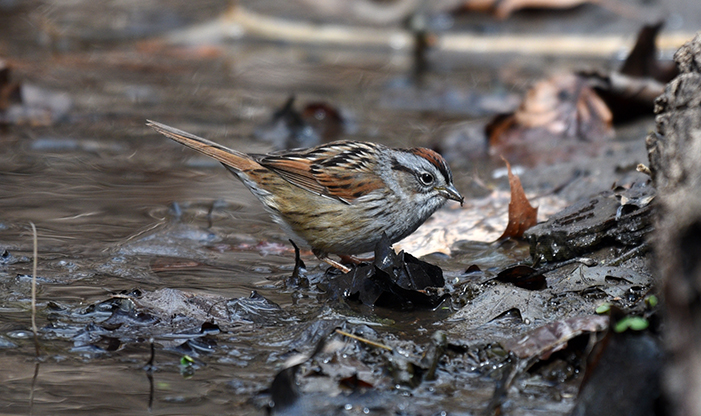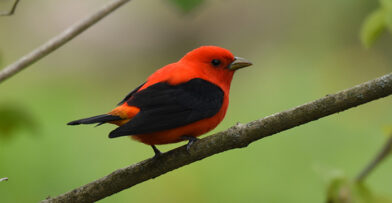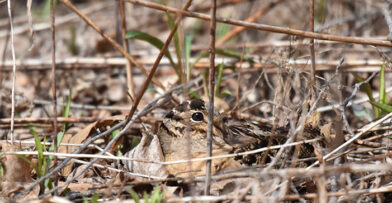Our Bird Profile series highlights a species that is migrating through, breeding, or is a year-round resident of Wisconsin that can be found at Schlitz Audubon or in your backyard.
Name
Swamp Sparrow, Melospiza georgiana
Basic Description & Appearance
Named for their preferred habitat near swamps and other wetlands, the small to medium-sized Swamp Sparrow measures 12.5-14.5 cm in length, with the male slightly larger than the female. The adults are rusty brown on top, streaked with black, with chestnut on the outer wing and black inner wing coverts. Their face and outer neck are grayish, with brown eye line, and white throat. This species is sexually dimorphic, expressed in alternate plumages. The male’s crown is a richer color with a fuller colored chestnut cap, with a prominent gray brow stripe.
Vocalization
The Swamp Sparrow is often heard before being seen. Their song is a slow trill, with high-pitched weet-weet-weet notes. The song consists of multiple syllables, with 2-5 notes in each. Males sing during courtship and to establish and defend their territory. They also have a flight song.
The female is known to give a nest departing call of short chip notes during nest-building, incubating, brooding, and nestling care.
Habitat & Nesting
The Swamp Sparrow’s breeding range is in boreal Canada and the eastern U.S., including Wisconsin. They are short-distance migrants, travelling only as far south as Central Mexico, with most wintering in southeastern U.S.
During breeding season, you will find Swamp Sparrows in wetland habitats, including boreal bogs, sedge swamps, cattail marshes, and wet brushy meadows. They will often congregate near the lower parts of vegetative areas where they like to hide. During migration, they are sometimes found away from water, located in pastures, brushy areas, and old fields. Although they are considered shy birds, they are visible if you know where to look.
During nesting, the nest sites are chosen by the female, with most nests slightly elevated above water, although they are occasionally found on the ground. Males carry nest material to the females, but don’t participate in making it. The nest is a cup constructed of an outer layer coarse, dry grasses and sedges, twigs, and other rough material. The interior is made of finer grasses and sedges, with occasional additions of rootlets, plant fibers, and plant down.
The average clutch size is 3-4 eggs, which are a cloudy blue-green color. The female incubates the eggs for an average of 12 days, depending on temperature. Birds hatch with closed eyes, which open after 4-5 days. The young birds depart from the nest after 9-11 days.
Diet & Foraging
This bird’s winter diet includes fruits and seeds, supplemented with aquatic invertebrates when available. During the breeding season, their diet consists of mostly insects found in wet habitats. This includes spiders, adult damselflies and dragonflies, beetles, flies, and more. During all seasons, they forage near edges of water picking insects, as well as in shallow, open water. When they are on land, they also glean invertebrates and seeds from wet ground, and insects from stems, leaves, and the lowest branches of herbaceous plants.
When & Where to Find at Schlitz Audubon
This species is found in our wetland habitats, peaking during spring migration in April and May, and during fall migration in October. You will see them in areas of the Central Wetlands Loop and our Hardwood Swamp area. Swamp Sparrows can be secretive and move quickly in and out of their brushy habitats, so it may take a bit of patience to get a good view.
Other Fun Facts
- Swamp Sparrows have longer legs than most in their genus, allowing them to walk directly into open water to forage for food.
- The Swamp Sparrow will occasionally dip their head under the surface of the water to capture aquatic insects.


